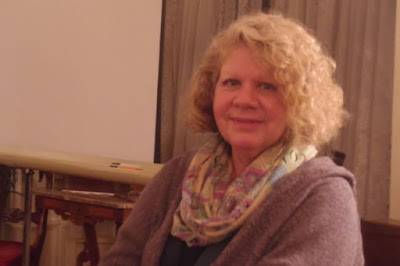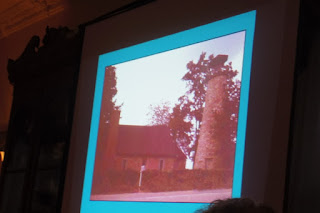On April 6th, Carol Rogers from the New York State Office on Parks, Recreation, and Historic Preservation, gave a presentation on Lighthouses of the Seaway Trail and the East Coast at the regular meeting of the Grand Island Historical Society. Here are some tidbits from the meeting.
Lighthouses have existed for centuries. The first lighthouse was the Lighthouse of Alexandria. Construction began in 290 B.C. and it took twenty years for the lighthouse to be completed. Ptolemy Sotor was the ruler of Egypt at the time and his goal was to provide light for sailors to come to port. The light on top of the lighthouse was a large fire and, inside, there may have been a large mirror to focus the fire on the water. The lighthouse was 450 feet tall and had internal stairs. It was damaged by three earthquakes and eventually fell to ruins. There is no longer anything left of that lighthouse.
The oldest functional lighthouse in the world is the Tower of Hercules, an ancient Roman lighthouse in Galicia, Spain. It is the second tallest lighthouse in Spain. The tallest is Faro de Chipiona. It has existed since at least the second century A.D. It is a UNESCO World Heritage Site, as well as a Spanish Property of Cultural Interest.
The oldest lighthouse in the United States is the Sandy Hook lighthouse in New Jersey. It was designed and built in 1764 by Isaac Conro. It has never needed repairs and is still functional.
Lighthouses have changed over the years. In 1822, Augustin-Jean Fresnel created a lens that resembles a beehive, with pieces that all come apart. The Fresnel lens has a clockwork mechanism. In the past, lighthouses were powered by oil lamps. Later, the power source was electricity and some lighthouses are still powered by electricity. Today, many lighthouses are solar powered.
There are many lighthouse stories. The most fascinating one is about a woman named Kate Walker. She was born Katherine Gortler in the 1850s in northern Germany. She married and had a son, Jacob. After her husband died, she took her son to the United States, where she met John Walker, who taught her how to speak English. They married and moved to the Robbins Reef Lighthouse in New Jersey. “The sight of the water made me lonesome,” she said.
Kate worked alongside her husband as the assistant lighthouse keeper. He was paid an annual salary of $600, and her salary was $350. Unfortunately, in 1886, John passed away from pneumonia. His last two words were “mind the light, Kate.” She then worked as the lighthouse keeper, but, because she was a small woman (four foot ten), it might have been thought that she was not capable of being the lighthouse keeper. After several years, she did get that title and she served as lighthouse keeper until 1919, when she retired.
Kate was a hard worker. Every morning, she rowed Jacob and her daughter Mary to school in Staten Island. She made a home in the lighthouse for her family and she always minded the light. She saved the lives of fifty sailors from shipwrecks and said of the folks whom she rescued: “I never made up my mind whether they were courageous or stupid.” Eventually, Jacob was hired to be Kate’s assistant. On foggy nights, Jacob and Kate stayed up all night. They sounded a siren that the sailors could hear to warn them of the danger of coming into a shore that they were unable to see in the thick fog.
Kate served as lighthouse keeper for so many years that the lamp was called “Kate’s Light.”
Kate was at home in the lighthouse but out of her element in New York City. She was afraid of the city and scared of automobiles. When she retired in 1919, she left the lighthouse and moved into a cottage in Staten Island. She had a garden to tend and she often could be found looking across the harbor at the Robbins Reef Lighthouse. She passed away in 1935. Four years after Kate died, the Coast Guard took over the lighthouse. It took three men to do the job that Kate did, either by herself or with her son, Jacob.
Here are some of the other lighthouses that Carol mentioned:
- The Presque Isle Lighthouse, in Erie, Pennsylvania, was originally built in 1818 and was restored in 1867. It was built at the same time as the main lighthouse in Buffalo, called the Buffalo Main Light. There were a bunch of lighthouses in Buffalo and in the immediate area. These included the South Side Lighthouse, the Horseshoe Reef Lighthouse, the Grand Island Lighthouse, and the Thirty Mile Point Lighthouse. The Thirty Mile Point Lighthouse in Barker, New York, got that name because it is thirty miles from the Niagara River. “I’ve been up there,” Carol said. “I’ve seen bald eagles. There are dangerous shoals.” The Thirty Mile Point Lighthouse is now a museum that is open for tours between May and Labor Day. There is an apartment upstairs that is rented out. Communities that wanted a lighthouse keepers had to submit information to the federal government that there were shipwrecks and that they needed a light. The lighthouses were part of a federal program that was first administered by Alexander Hamilton.
- The Selkirk Lighthouse in Port Ontario, New York, was built in 1836, near the marina. It is now a bed and breakfast.
- The Sackets Harbor Lighthouse, built in 1870 is very self sufficient, with a garden, an outhouse, and a fuel house.
- The Rock Island Lighthouse in the Thousand Islands was a place where no one wanted to go. This lighthouse, built in 1847, was surrounded by water, so it was very secluded. The winters there are very harsh so anyone working there would be completely cut off from the outside world for months on end.
- The Odgensburg Harbor Lighthouse, now privately owned, housed cholera victims during the Civil War.
- The Montauk Point Light House, in eastern Long Island, near Montauk Point State Park, was built in 1797. It is open for tours. You can climb the tower and visit the museum. There is a trail for hiking. People like to fish for striped bass. According to Carol, the lighthouse was built on Long Island’s “wild shore.” The Atlantic Ocean swirls and churns, causing a great hazard for ships coming to shore.
- The Statue of Liberty. It’s a lighthouse! It was built in 1886. Is it in New Jersey or in New York? Who knows?



Great history of lighthouses. There is a lighthouse in NC and we take the ferry to get to it. I love lighthouses.
Thanks for the story, Alice. Sorry I missed the program. My favorite lighthouse is on Block Island, Rhode Island. A number of years ago, the cliff on which it was located was eroding so badly that the lighthouse was in danger. It had to be moved several hundred feet back, a huge job, and fascinating job. Local connection: The feat was accomplished by the International Chimney Company, located in Williamsville. The company has also moved at lest one other lighthouse.
Barb B.